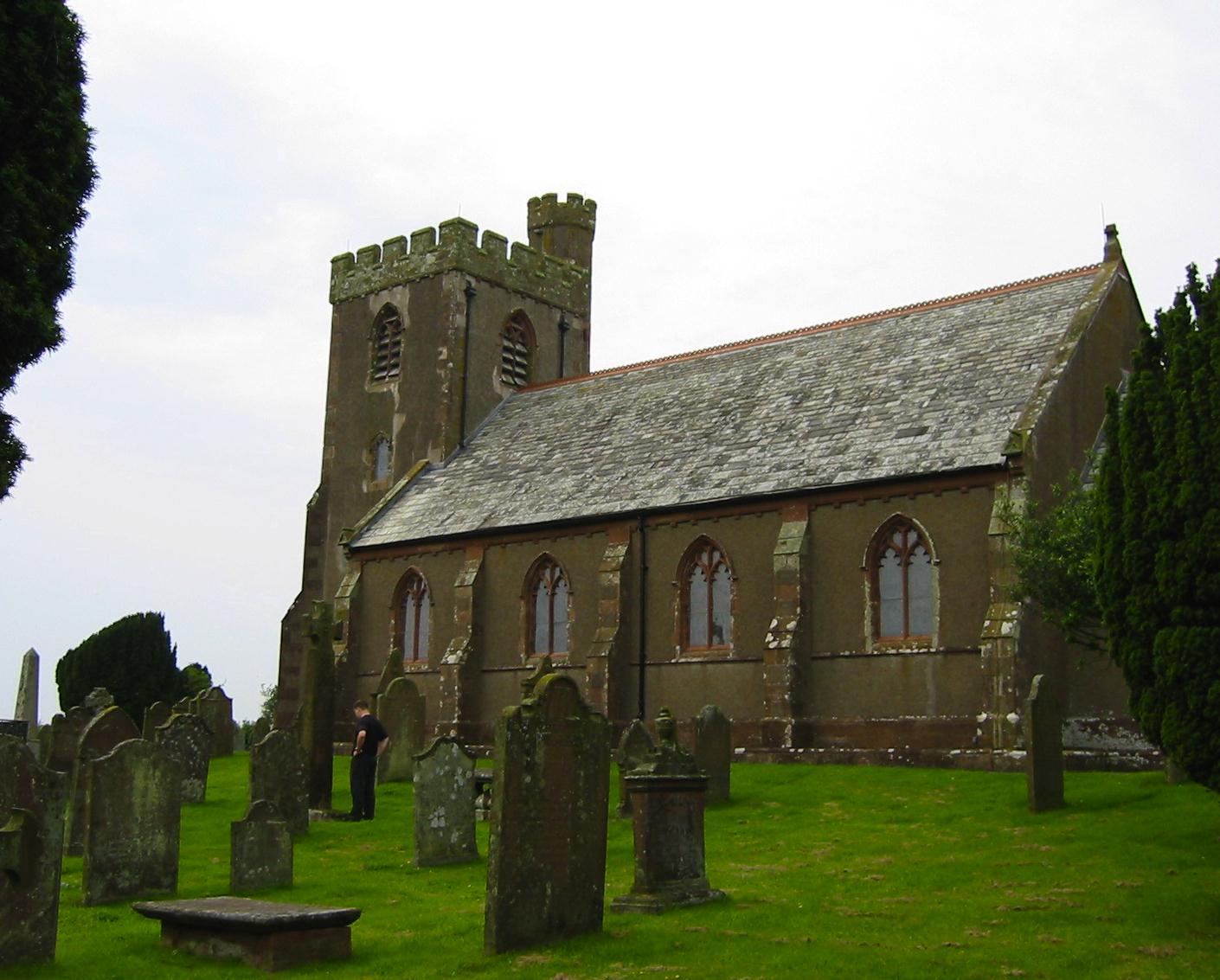August 6, 2002: Ravenglass To Nether Wasdale
At 5:00 on the morning of Tuesday, August 6, I rolled out of bed to begin last minute preparations for a major walking expedition – an assault on Lakeland’s Cumberland Way. This route, from Ravenglass on the Irish Sea to Appleby in Westmorland is, in fact, the second stage of a three-part circuit of the Lake District designed by Paul Hannon. Gavan and I had completed the first of these, the Furness Way, in 1994, and now I had to make certain that the lad was up and about – for he had arrived only the day before to accompany me on this expedition.
A great deal of planning had been undertaken to ensure the success of this outing, and I had made my bookings in May. Train reservations had been secured as well, but I had discovered, only a week before departure, that guards were planning a strike for our day of travel on the branch line, controlled by First Northwestern, from Lancaster! This had meant for me quite a few hours on the Internet, searching for alternative ways of reaching Ravenglass. On a walk like this, with all the bookings already made, you have to be at the starting point at a precise time or the entire structure collapses. I was even prepared, in the present instance, to take a bus from Lancaster to Ambleside and a cab to the coast – but the rail union came to a settlement with the rail company just before the weekend, and so I was able to relax a bit on this point.
Gavan had done a good job of bringing the right gear in his pack (though I did have to lend him some t-shirts) and, obviously jet-lagged, he accompanied me downstairs to a waiting cab at 5:40. A quick ride to Euston meant that there was plenty of time to buy coffee and Danish before boarding our waiting train. What a contrast with our last departure for the Lakes, when there had been a mad rush at the barrier for remaining seats on the day after another strike.
The journey was still a tedious one. Gavan, now 30 and still in shock after his recent unhappy departure from a seminary in Boston, read several articles on the state of his church by Gary Wills – pieces that I had saved for him from the New York Review. (I read quite a boring piece on Sinclair Lewis.) In hazy sunshine we arrived at Lancaster at 9:49 and, with some time on our hands, we walked into the town center in search of snacks. We never actually found a newsagent – town center having been turned over to mall-like pedestrian precincts, but Gavan found a supply of Snickers Crunchies in a discount store and, after a walk past the castle, I was quite content with the offerings in the railway buffet anyway.
We took the lift down to the platform and saw our train arrive from Whitehaven. We were off at 10:32 and there followed another tedious repetition of a journey I had taken many times. We passed Arnside, where we had begun the Furness Way, and Barrow, which was suffering from an outbreak of Legionnaire’s Disease. A group of teenage lads with their skateboards sat opposite us and they were replaced by a second set later in the journey. There were a few backpackers as well – just to remind us of our own purpose in undertaking this journey (the first for me with my own pack on my back in a long time).
Much relieved to step off the train at 12:19 – just when I had hoped to arrive – we rediscovered our last Furness Way pub, the Ratty Arms, backing onto the platform. So we sat inside and I had cod and chips while Gavan had a beef sandwich. The place was full of locals and there were interesting photos of the railway platform in much earlier decades – how much more formally the travelers of yesterday had dressed! While we were waiting for our food I wandered down the street behind the pub to get a look at the start of the route. Each of us used the toilet, we finished our beer, I took the legs off my trousers so as to walk in shorts, and at 1:15 we were off.
Our route called for us to walk down the “main street” of Ravenglass village, a double row of seaside cottages that ended at the same beach we had used to complete the Furness Way. A boy walking a dog accompanied us for a while but we were soon alone as we tuned left and found a wet path into the foliage that surrounded the railway line. This soon put us onto the track to Walls Castle and a few steps forward brought us to a gate at the edge of a rising grassy field.
I had purchased for Gavan a somewhat newer version of Paul Hannon’s guide and he was in charge of route finding from the start. I had my copy too, and occasionally I looked at it as well but, for the most part, I had no need. My pack was not too onerous and though the climb up to the woods above us required some deep breathing I found that I was quite up to the challenge. Gates took an early lead in their perpetual battle with stiles and eventually won the day 15-12.
After passing through woodland we reached the A595 and turned left to find a northerly track. Ravenglass soon receded behind us and ahead we could see the valley of the River Mitre. There were some ambiguities, especially as we began our descent and undertook a search for a path to Muncaster Mill. In retrospect I wish we had dropped to the highway immediately. Trying to utilize a route that Hannon had described as a “little damp” lead to the first major soaking for our boots – and a twisting and turning progress on waterlogged tracks above the mill. A “little damp” turned out to be a large understatement. On his way up was a chap in white trainers and we both had a chuckle over this poor choice of footwear. The mill itself was no longer a tourist attraction, just a private house now, but we paused in its environs for the first photo utilizing my new Canon digital camera – which was small enough to fit in my front pocket throughout this journey.
Then we walked out to the highway, crossed a river and a railway bridge and turned left with the A595. Just at this moment a train on the Eskdale miniature railway pulled in behind us and I took a picture of this too (I should have used the zoom). We then turned off on a hard and dry farm track and headed northeast for the Gasketh farm. This was relatively easy walking under humid, bright skies, with the sun overhead, and we made good progress up to the farm – where the track continued for another mile, in a more northwesterly direction, toward the distant tower of Irton church. Cars occasionally crawled down these hedgerow-encased lanes but there were no other walkers about and no one in the vicinity of the church – where we paused for our first rest.
This was actually a very lovely spot, with a 9th Century Anglian cross, and each of us did a circuit of the building, reading inscriptions on the tombstones. We had been rather spoiled by the hard surfaces of the trackways so far, but this was soon to change as we began to head east along fences and over marshy fields made muckier by the presence of the resident bovines. Hannon describes the precincts of Irton Hall as “parkland” but this would be true only if they had a park dedicated to quagmires and cow pies. Indeed one characteristic of the seldom-walked Cumberland Way was its substandard walking surfaces; we would soon have the twists and turns of an often pathless route for seven days.
It was with some relief that we now edged onto the more solid roadways of Irton Hall itself; it, too, seemed to have undergone a change of status since earlier editions of the guidebook – no longer a home for spastic children, it seemed to be in the tourist accommodation business now – and to be undergoing renovation.
We now headed north on tarmac, stepping aside for the odd hurtling car and climbing a hill before escaping this roadway on a path down to the River Irt. We had this body of water for company only a short while, soon finding ourselves at the Santon Bridge crossroads – where we crossed the bridge and plunged into the open door of The Bridge, a welcoming inn that was open at 5:00. Gavan had a long conversation with the bartender here about ale prices (which seem to rise with alcohol content) and I went outside to take a picture of the pub. Two chaps at a table in front of this establishment wanted to know if they should move. “Of course not,” I said, whereupon one of them attempted to supply some local color by slumping drunkenly over the tabletop.
After our pints we continued forward, walking on a variety of dodgy surfaces along the west bank of the Irt. It was easy to follow our progress from the clues on Hannon’s map, but sometimes the path disappeared and at other times it was quite eroded. We crossed the river via Hollins Bridge and continued on a lane to Hollins Farm, where a couple with a dog asked us for directions. I was able to pinpoint our location on their OS map and the chap offered advice on the muddy struggle we had ahead of us. Gavan, who is extremely sensitive to smells, later objected to the whiffs of b.o. rising from this fellow whenever he raised his arm to point.
Mud there was – and there were some desperate crossings as we struggled forward on farm tracks; when we turned right to head toward the farm at Stagends the footing improved somewhat but we soon had to leave the comfort of this lane and head into woods surrounding the Irt, which we crossed on a footbridge. Here, with more fell-like surroundings rising above us, we floundered about searching for the right route – at last locating a lane that deposited us on the highway at Strands. We had walked nine and a half miles.
This was a moment of great excitement for us, as we had reached Wasdale itself and could see the fells to the east. Indeed, Nether Wasdale is the alternative name for this quiet village, where one pub, The Screes, dominates the north side of the road and our hotel, The Strands, the south. It was 6:30.
The lady publican welcomed us and spirited away our boots to the boiler room. Then she led us to a twin-bedded room, with en suite facilities, on the first floor, and here we relaxed and each had a shower. (Gavan always let me go first, as he was suffering from athlete’s foot – though he had thoughtfully brought a can of Lysol to kill any surviving evidence in the tub.) In the bar we had some drinks and then we ordered our food – I had a very mild curry. Our meal was syncopated by the endless rumblings of a Neil Diamond tape and when Rosie began crackling for the third time we rose. Outside it was almost dark and a gentle quiet descended over the peaceful scene. We were asleep by 10:00.
To continue with our next stage you need:



